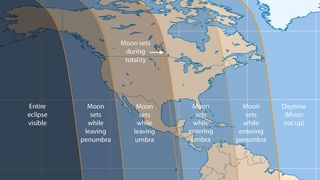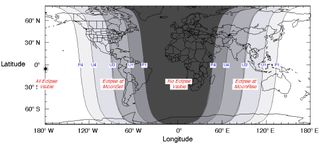
Turnabout is fair play: The full moon will be totally eclipsed early Saturday morning (April 4), just 15 days after it caused a total eclipse of the sun.
Observers throughout western North America, Oceania and eastern Australia will be treated to a total lunar eclipse Saturday, weather permitting. People in many other locations around the world will witness a partial eclipse.
The event is the first of two eclipses of the moon in 2015, will be webcast live online Slooh community observatory at www.slooh.com. Slooh's "Breakfast on the Moon" webcast will begin at 6 a.m. EDT (1000 GMT) at and include views of the event from Australia, Hong Kong and the United States. You can also watch the total lunar eclipse webcast on Space.com, courtesy of Slooh.
It's no surprise that this lunar eclipse is coming so close on the heels of a solar eclipse. Solar eclipses can occur only when the moon is at a "node" in its orbit. (The nodes are the two points where the moon's path on the sky crosses the sun's path, which is called the ecliptic.) [How to See the April 4 Lunar Eclipse (Photo Guide)]
During the March 20 solar eclipse, the moon crossed the ecliptic from north to south and cast its shadow on the Earth. On Saturday, a half orbit later, the moon will cross the opposite node from south to north, becoming engulfed in Earth's shadow.

Best views? Go west!

Saturday's eclipse will be visible to varying extents across North America. The farther west one goes, the better the view, because moonset will be approaching as the eclipse begins. NASA has put together a video overview of the total lunar eclipse, which will be the shortest of the 21st century.
Earth's shadow consists of two parts: a faint outer region, called the penumbra, and a much darker inner shadow called the umbra. The moon will enter the penumbra at 5:01 a.m. EDT (2:01 a.m. PDT; 0901 GMT), though the effect will not become evident to most eyes until about 55 minutes later. To spot the penumbra, look for a faint bit of darkness, a "soiled" or "smudgy" appearance on the left rim of the moon.
Get the Space.com Newsletter
Breaking space news, the latest updates on rocket launches, skywatching events and more!
The satellite will make first contact with the darker umbral shadow at 6:15 a.m. EDT (3:15 a.m. PDT; 1015 GMT). This is when the action really starts; it will appear as if a bite were taken out of the moon's disk. [Must-See: Best Skywatching Events of 2015 (Infographic)]
East of a line running from central Minnesota to central Louisiana, the moon will set before total eclipse. From Boston, roughly 11 percent of the moon's diameter will be eclipsed when it sets at 6:26 a.m. EDT. New York will see about 24 percent coverage at moonset (6:39 a.m. EDT). Farther west, the progression of the moon into the umbra will be much greater; in Chicago, for example, it will be 77 percent (6:34 a.m. CDT).
The table below lists how much of the moon's diameter is inside the dark umbral shadow when it sets as seen from eight selected eastern cities:
Location Moonset Percent Covered
Boston | 6:26 a.m. | 11 |
Montreal | 6:34 a.m. | 19 |
New York | 6:39 a.m. | 24 |
Washington | 6:53 a.m. | 37 |
Miami | 7:13 a.m. | 57 |
Atlanta | 7:26 a.m. | 70 |
Chicago | 6:34 a.m. | 77 |
New Orleans | 6:51 a.m. | 94 |
An extremely short totality

The duration of totality, or total eclipse, will be extremely short. According to NASA astronomer Fred Espenak, totality begins at 7:57:54 a.m. EDT (5:57:54 a.m. MDT; 4:57:54 a.m. PDT; 1157:54 GMT) and lasts just 4 minutes and 43 seconds. In fact, this will be the shortest total lunar eclipse of the 21st century.
This is because the moon will just barely become entirely immersed within the umbra. In fact, at mid-eclipse, the moon's northern limb is tucked within less than 2 miles (3.2 kilometers) of the outermost edge of the umbra!
Around the time of totality, the moon should appear to glow dimly with a ruddy or coppery glow, the result of all the sunrises and sunsets occurring at that time on Earth, whose light has been refracted (bent) into the planet's shadow.
After totality, the western half of North America will see the moon gradually emerge from the umbra. For most observers, moonset will intervene before the moon completely exits the shadow, although along the West Coast, the moon's last contact with the umbra (on its right/western rim) can be glimpsed before local moonset at 6:44 a.m. PDT (1344 GMT).
But a very long partial eclipse
Interestingly, while the duration of totality of the lunar eclipse is exceedingly short, the time from when the moon first touches the dark umbra until the moment totality begins is abnormally long, running 102 minutes.
Why so long? In part, this is due to the moon's path into the shadow; the satellite's upper limb gives the umbra's outer edge a glancing blow. But more importantly, the eclipse comes three days after the moon arrived at apogee, its farthest point from the Earth. So the moon's orbital velocity is quite slow, and the natural satellite will take a rather leisurely trek through Earth's shadow.
In contrast, during the next total lunar eclipse, on Sept. 27, the moon will be within an hour of perigee, its closest point to Earth. On that date, the so-called "supermoon" will take a deeper plunge through the umbra and will also be moving close to its maximum orbital velocity. So from the moment of first umbral contact to the start of totality, only 64 minutes will elapse.
Eclipse on Easter Sunday
The upcoming lunar eclipse will occur on Easter Sunday in some parts of the world. At first, this doesn't seem possible, since, according to ecclesiastical rules, Easter falls on the Sunday that follows the first full moon of the spring season — the so-called Paschal Moon.
For most parts of the world, the first full moon of the current spring season occurs tomorrow, on a Saturday. And in this particular case, there will also be an eclipse. The next day is Sunday (April 5), and that is the day designated as Easter.
However, if you head far enough to the east of the Greenwich meridian, which goes through England, Saturday's full moon becomes Sunday's full moon. At Greenwich, mid-eclipse occurs Saturday at 12 p.m. local time. But for New Zealand and easternmost Russia, clocks run 12 hours ahead of Greenwich — that is, at midnight on Easter Sunday.
Editor's Note: If you snap an amazing picture of the lunar eclipse Saturday or any other night sky view that you'd like to share for a possible story or image gallery, send photos, comments, and your name and location to managing editor Tariq Malik at spacephotos@space.com.
Joe Rao serves as an instructor and guest lecturer at New York's Hayden Planetarium. He writes about astronomy for Natural History magazine, the Farmer's Almanac and other publications, and he is also an on-camera meteorologist for News 12 Westchester, N.Y.Follow us @Spacedotcom, Facebook or Google+. Originally published on Space.com.
Join our Space Forums to keep talking space on the latest missions, night sky and more! And if you have a news tip, correction or comment, let us know at: community@space.com.

Joe Rao is Space.com's skywatching columnist, as well as a veteran meteorologist and eclipse chaser who also serves as an instructor and guest lecturer at New York's Hayden Planetarium. He writes about astronomy for Natural History magazine, the Farmers' Almanac and other publications. Joe is an 8-time Emmy-nominated meteorologist who served the Putnam Valley region of New York for over 21 years. You can find him on Twitter and YouTube tracking lunar and solar eclipses, meteor showers and more. To find out Joe's latest project, visit him on Twitter.